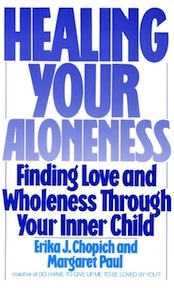Beyond Fear and Addiction
By Dr. Margaret PaulDecember 31, 2006
Addictive behavior, a form of self-abandonment and unloving way of dealing with painful feelings, is a major cause fear, anxiety, and depression.
 There is a wonderful acronym for fear:
There is a wonderful acronym for fear:
False
Evidence
Appearing
Real
Much of the fear in our lives is based on false evidence.
Our bodies are designed to respond with the fight or flight mechanism to real and present danger - such as being physically attacked. In the face of real and present danger, the adrenaline flows and the blood drains out of our organs and brain and into our limbs to prepare us for fight or flight.
Yet many people spend much of their time in the anxiety and stress of fight or flight when there is no real and present danger. This is because the body responds the same way to imagined danger as it does to real danger. The body thinks that the false evidence coming from our thoughts is real.
This constant state of fear and anxiety often leads to various addictions in the hope of numbing out the painful feelings. Food, alcohol, drugs, nicotine, gambling, sex, porn, TV, shopping, approval, attention, work, anger, rage, violence to self and others - all can be used in attempts to block out painful feelings.
However, the addictions themselves are self-abandoning, in that they are not a healthy and loving way of dealing with painful feelings. And it is self-abandonment that causes the most fear, anxiety, and depression.
Many people are caught in a very negative circle based on self-abandonment...
-
Thinking negative thoughts about the future - about rejection, failure, loss of others, loss of self, loss of money - creates fear in the body and is an abandonment of self.
We are abandoning ourselves when we allow ourselves to make up thoughts about the future that scare us. This would be like saying to a child, "You are going to end up alone. No one will ever love you. You will be out on the streets with no food and no help." Saying this to a child would be considered child abuse, yet many people tell these same things to themselves over and over when there is no objective truth to these statements.
-
Once we have created fear with our negative thinking, we try to avoid the fear with our various addictions.
Avoiding responsibility for creating our fear by turning to addictions is another form of self-abandonment. This is like offering a frightened child a cookie instead of addressing the source of the fear. The self-abandonment creates deep inner emptiness and aloneness, which perpetuates the addictive behavior. It also creates neediness, leading to pulling on others for love, approval and attention.
- Addictive behavior perpetuates the original fears - an endless vicious circle of self-abandonment.
Moving Beyond Fear and Addiction
There really is a way out of this! While the Inner Bonding process for moving beyond fear and addiction is simple, it is not easy. It takes deep commitment and devotion to your peace and joy.
-
Choose the willingness to feel your painful feelings and take responsibility for creating them, rather than continue avoiding them with your various addictions. It is only when you are willing to be present with your feelings, rather than avoid them, that you can learn about how you are creating your own pain.
-
Consciously decide that you want to learn about what you are thinking or doing that is causing your pain.
-
Dialogue with the part of you that is in fear and pain - you can think of this feeling part of you as an inner child - about how you are causing the pain. Discover your thoughts, false beliefs and actions that are causing your pain.
-
Open to learning with a higher power - your own highest wisest self, an inner teacher or mentor, a guardian angel, God - about what is the truth regarding your negative thinking and what the loving action is toward yourself.
-
Take the loving action for yourself that you are guided to do in Step 4.
- Notice how you feel. If you feel more peaceful, then you know that you have taken loving action. If not, then you need to go back through these steps to discover another loving action.
This is the Inner Bonding process. Practicing it will move you beyond fear, addictions and self-abandonment.
 Send this article to a friend
Send this article to a friend  Print this article
Print this article  Bookmarked 4 time(s)
Bookmarked 4 time(s)
Comments
| Author | Comment | Date |
|---|---|---|
| Join the Inner Bonding Community to add your comment to articles and see the comments of others... | ||

Daily Inspiration
When we connect with Spirit and we fill ourselves with love, our love overflows and we want to share it with others. How do you want to share your love today? How do you want to show your caring? What service to others do you want to express today?
By Dr. Margaret Paul

 Share with Del.icio.us
Share with Del.icio.us Share with Digg
Share with Digg







